The El Niño phenomenon is set to return, and humanity may soon witness the hottest period in history, accompanied by terrifying natural disasters.
CNN reports that ocean temperatures have reached record highs over the past four years, according to scientists’ reports from January. By mid-March, climate scientists warned once again that global sea surface temperatures have risen to a new high.
This trend has experts worried about the future, especially as forecasts indicate that El Niño is expected to begin this summer—bringing with it negative impacts such as extreme heat, tropical storms, and significant threats to coral reefs.
What is El Niño?
El Niño is a major weather phenomenon that affects the global scale. It is described as a cyclical climate change lasting from 2 to 7 years, during which tropical sea surface temperatures in the central and eastern Pacific rise sharply and persistently above the long-term average.
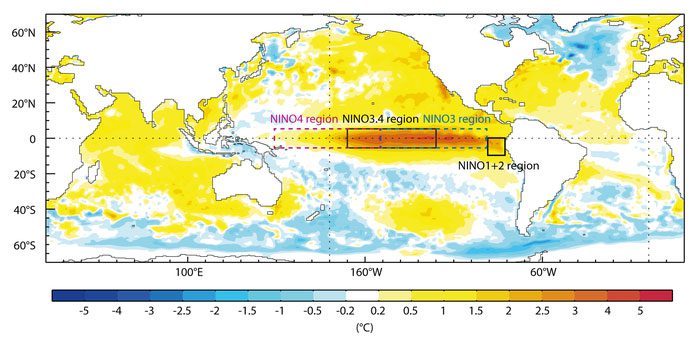
Temperature increase in some areas of the central and eastern Pacific during El Niño 2015-2016.
The term El Niño, meaning “the Christ Child” in Spanish, originates from South American residents. It usually occurs in Peru and Ecuador during winter and is associated with Christmas events.
El Niño triggers various phenomena globally. In the central Western Hemisphere, it can cause droughts, hotter, and more uncomfortable weather. Additionally, it can lead to heavy rainfall and flooding in some areas while causing drought and wildfires in others.
This phenomenon affects the lives of millions, particularly those living in coastal regions of the Pacific. It can result in natural disasters such as severe flooding, famine, water shortages, and health issues.
The El Niño phenomenon is explained by the increase in sea surface temperatures in the central Pacific, driven by rising global greenhouse gas emissions. Higher temperatures lead to disruptions in thermal currents within the atmospheric and climate systems globally, causing significant changes in the natural environment.
Negative Impacts of El Niño in History
Looking back at historical data, the 20th century recorded the two worst El Niños occurring in 1982-1983 and 1997-1998. The most recent “super” El Niño in 2015-2016 was noted for its “strength” and set new records for several regions in the central Pacific.
The 2015-2016 El Niño event was one of the strongest ever recorded, with ocean temperatures in the eastern Pacific over 2 degrees Celsius higher than average. This had significant impacts on weather patterns worldwide, leading to severe droughts, flooding, and wildfires in various regions.
In South America, El Niño caused heavy rainfall and flooding, particularly in the northern regions of Peru and Ecuador. Landslides and natural disasters inflicted significant damage on infrastructure and agriculture. Additionally, El Niño led to a decline in fish populations, affecting the livelihoods of local fishermen.
In Southeast Asia, El Niño caused prolonged droughts and heatwaves, resulting in severe crop failures and food shortages, significantly impacting the livelihoods and lives of the people.
In Africa, El Niño delayed the rainy season, leading to crop failures and food shortages in countries like Ethiopia and Zimbabwe, exacerbating already difficult living conditions in the region and causing many to be displaced.
Besides these impacts, El Niño also led to significant weather events in other regions, such as hurricanes and tornadoes in the United States and Canada, and wildfires in Indonesia and Australia.
The effects of the 2015-2016 El Niño event are still being felt in the years following the occurrence. This event underscores the importance of understanding and monitoring El Niño and other weather patterns, as well as the need for better preparedness and response measures to mitigate their impacts on affected populations.
The 2015-2016 El Niño event must be viewed in the context of global climate change. The year 2016 was a record hot year (to date) due to a combination of global climate change and El Niño. El Niño directly added 0.12 degrees Celsius to the global temperature in 2016.
Global sea levels also rose by 7mm due to thermal expansion. For 12 consecutive months, global temperatures reached new records for the first time in history.
Unforeseen Consequences
Will the 1.5 Degrees Celsius Threshold Be Surpassed? Will 2023 Be the Hottest Year?
Annual average global temperatures in recent years have increased by more than 1.2 degrees Celsius compared to pre-industrial levels (1880).
Nations have joined the Paris Climate Agreement of 2015 to commit to limiting global warming to below 2 degrees—preferably 1.5 degrees—compared to pre-industrial temperatures. Scientists regard a warming of 1.5 degrees as a critical tipping point; exceeding this level raises the likelihood of severe flooding, droughts, wildfires, and food shortages significantly.
Adam Scaife, head of long-range forecasting at the UK Met Office, stated that a strong El Niño could push the planet beyond that threshold, even if only temporarily.

A strong El Niño could push the planet beyond that threshold, even if only temporarily. (Illustrative image)
Josef Ludescher, a senior scientist at the Potsdam Institute for Climate Impact Research, said, “We may have the hottest year on record globally in 2024.” The current hottest year on record is 2016, following a very strong El Niño.
Although we have experienced three years of cooling due to La Niña, temperatures are still surging to dangerous levels.
Europe experienced its hottest summer in 2022, with temperatures exceeding 40 degrees Celsius. Pakistan and India faced a severe heatwave, with many regions exceeding 49 degrees Celsius.
The crux of whether the 1.5-degree threshold will be breached is “not really important,” Scaife said. “For the first time in human history, that value is within reach—and that is key.”
Scaife noted that regardless of the exact temperature increase that El Niño brings, some of its impacts—including extreme temperatures—are likely to be unprecedented. “Every time we experience El Niño from now on, it will add to the increasing global warming we have accumulated so far.”
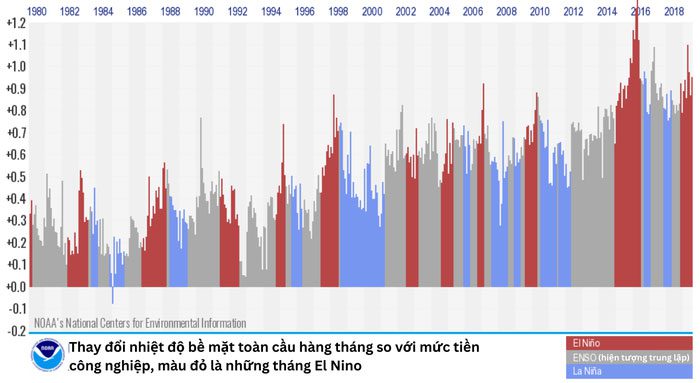
In 2016, there was a month that recorded an average temperature increase of 1.3 degrees Celsius.
“El Niño is often associated with record-breaking global temperatures. It is still unknown whether this will happen in 2023 or 2024, but I think it is more likely to happen than not,” said Carlo Buontempo, director of the EU’s Copernicus agency.
Friederike Otto, a senior lecturer at the Grantham Institute of Imperial College London, stated that temperatures caused by El Niño could exacerbate the impacts of climate change that countries are experiencing—such as severe heatwaves, droughts, and wildfires.
Otto remarked, “If El Niño develops, it is very likely that 2023 will be hotter than 2016—considering that the world continues to warm as humanity continues to burn fossil fuels.”
Drought, Heatwaves, and Wildfires
South Africa and India are at risk of severe drought and heatwaves, as well as countries near the Western Pacific, including Indonesia, Australia, and Pacific island nations like Vanuatu and Fiji.
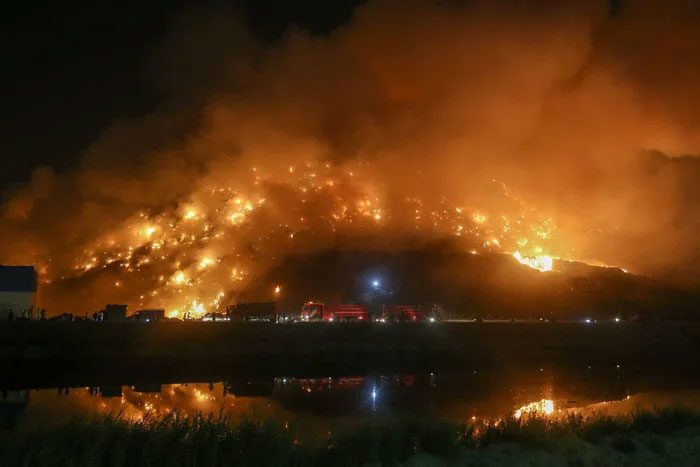
El Niño can amplify droughts, intense heatwaves, and wildfires.
For Australia—still reeling from widespread flooding—El Niño is likely to bring much drier and hotter weather, particularly in the eastern regions of the country. Since 1900, 18 out of 27 El Niño years have been accompanied by widespread drought in winter and spring, according to a spokesperson from the Australian Bureau of Meteorology.
Recent flooding in Australia has also raised concerns about an especially destructive wildfire season, as the increased vegetation growth may provide fuel for fires as the weather becomes drier and hotter.
India is also preparing for the impacts of El Niño, a phenomenon that could weaken the monsoon that brings the rainfall the country relies on to replenish aquifers and cultivate crops.
Stronger Storms
Unlike La Niña, El Niño tends to reduce hurricane activity in the Atlantic but creates the opposite effect in the Pacific, where warmer waters can fuel more intense storms.
Gottschalck stated: “Tropical storms can often form further west in the basin and maintain strength for longer periods, thereby increasing potential impacts on Hawaii. This means there are more opportunities for landfall and remote impacts, such as stronger and prolonged sea conditions, heavy rainfall,…”
For Pacific island nations that continue to be victims of the climate crisis, activists argue that a United Nations consensus is needed to protect future generations.
Elsewhere in the Pacific, Swain noted that models indicate “very warm water” off the coast of Peru has led to unusually heavy rainfall and flooding in deserts. “This is a classic harbinger of a significant El Niño event.”
Coral Destruction
When temperatures rise too high, corals expel the living algae from their tissues, which provide them with both color and a significant portion of their energy. This process causes corals to turn white—a phenomenon known as coral bleaching. Although they can recover if temperatures cool down, bleaching increases their risk of starvation.
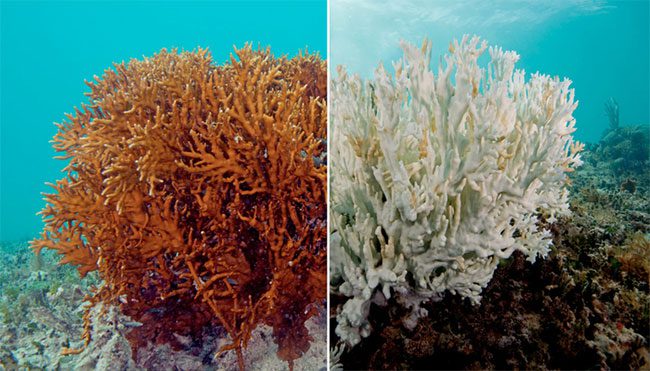
Warming oceans are bad news for coral reefs.
A particularly devastating coral bleaching event occurred from 2014 to 2017, affecting every major coral reef on Earth. The Great Barrier Reef in Australia witnessed nearly 30% of its coral die during the record marine heatwave in 2016, following a significant El Niño event that began in 2015.
Many mass bleaching events have occurred since then, and with El Niño approaching, scientists are increasingly concerned about the impacts on corals that do not have sufficient time to recover.
Ice Melting
Ice in Antarctica has been struggling with global warming, and El Niño could exacerbate the situation.
Earlier this year, the ice levels on the continent fell to a record low for the second time in two years, raising concerns that after many years of fluctuations, the amount of Antarctic ice is now on a sharp decline.
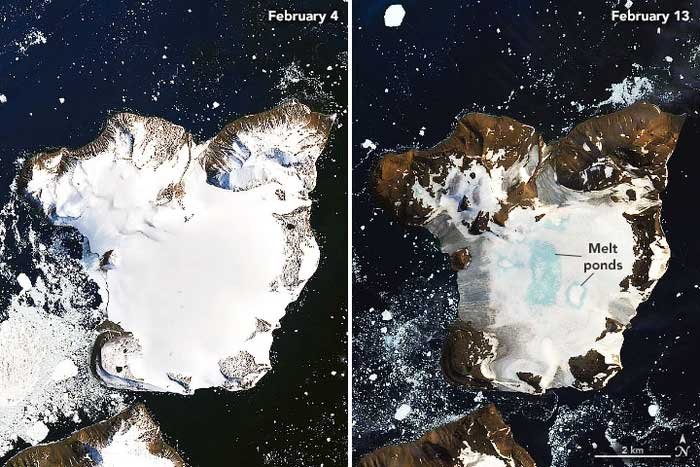
Changes in ice levels on an island near Antarctica over nearly 10 days in 2020.
El Niño could help accelerate this process, according to a recent study that shows a link between the intensity and frequency of El Niño events and the rate of ice melting in Antarctica.
Wenju Cai, a principal research scientist at CSIRO, Australia’s national science agency, told CNN: “Models predict that an increase in El Niño events will systematically lead to faster ice melting.”
Scientists are closely monitoring Antarctica because it contains a massive amount of water in its ice sheet. Although the Antarctic ice sheet is unlikely to melt entirely, it holds enough water to raise global sea levels by 70 meters—meaning many coastal areas where humans live would be lost.
Cai noted that, for now, El Niño events have different impacts across Antarctica, with increases and decreases in various regions. But he concluded that the trend is very clear—“the overall decline of sea ice.”


















































